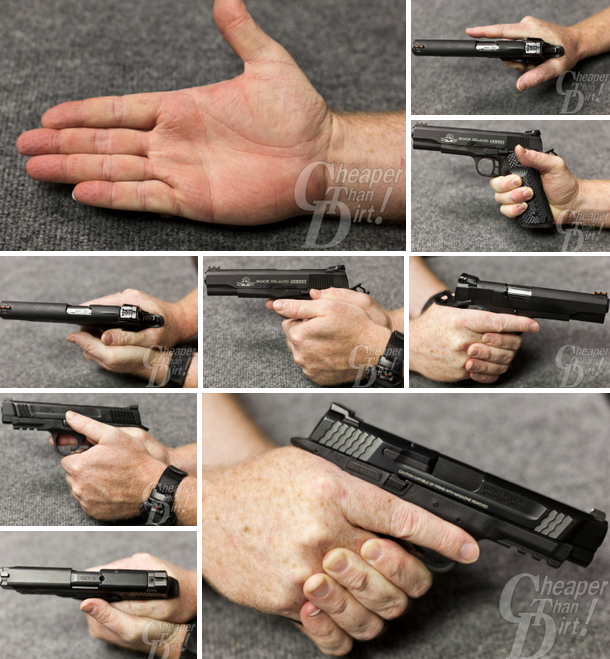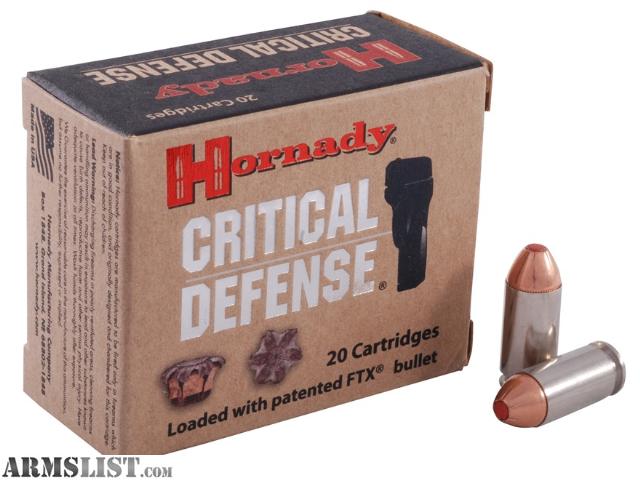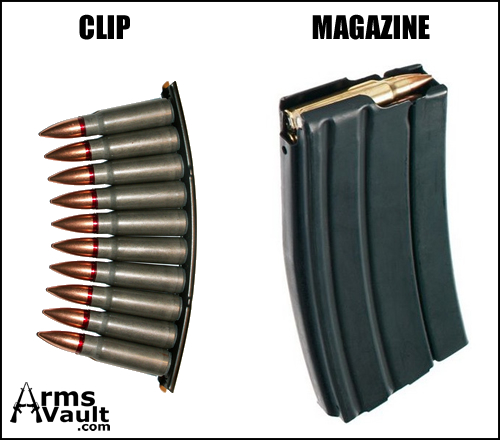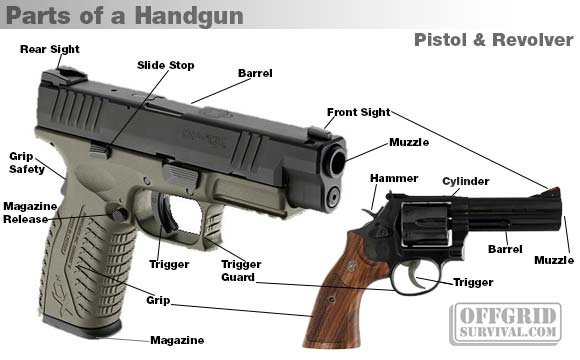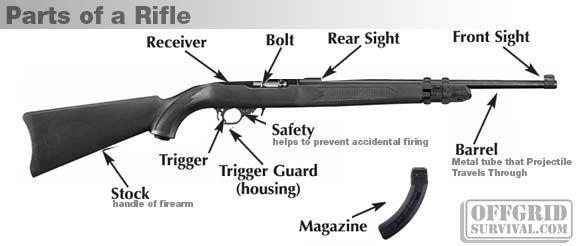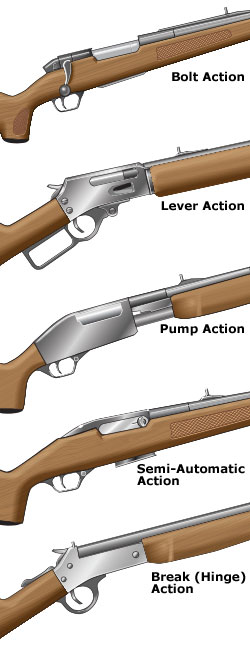OH SHIT, IT'S MY FIELD OF PERSONAL EXPERIENCE AND STUDY TIME!
Ahem. I mean, I would be perfectly happy to answer whatever questions you have because of my background in both owning firearms and having served in the military, along with a poopload of time spent reading military non-fiction stuff, I should be able to explain everything in a reasonably detailed and accurate way.
Letsa go.
- How does one fire a gun without horribly injuring themselves like an idiot?
Those lovely protrusions coming out of the back of the rifle? It's a stock, and it is your best friend in controlling a firearm (hand guns, obviously, don't have this luxury because it utterly defeats their purpose, which is as a secondary defense weapon when your primary weapon goes down, or you need something that can be used to react quickly to threats like in police work). No real rocket science on how to use it properly, you simply bury it into your preferred shooting shoulder, although not on the bone unless you feel like making shit uncomfortable for yourself. It should feel natural and comfortable to the shooter, although if you're wearing any form of armour, webbing, or tactical vest, you might be kind of limited in where you can rest it; as long as it's stable, that's the most important part. That's why collapsible stocks are really popular, it lets you adjust the length of the butt stock to match the shooter's body proportions. If you have a bulky outfit, it will make a shorter stock length much more comfortable for the shooter because the extra padding/ pouches/ fabric will push out where the weapon will sit, which may make operating it uncomfortable or unnatural. On the flip side, having too short of a stock is a common complaint a lot of shooters have for guns, and while it's totally possible for a larger stature shooter to be effective with those weapons, just imagine yourself like a T-rex with scrunched up arms for a very crude idea of why that can be slightly awkward for doing stuff like changing a magazine or making sight adjustments.
Another thing I'll touch on briefly that also ties into the next question is caliber. A pistol caliber weapon like a submachine gun will have very little recoil compared to a full-sized assault rifle with an intermediate cartridge that was designed to bridge the gap between an SMG and a machine gun, or god forbid you're a sadist and you want to fire a battle rifle on automatic, which fires full-sized cartridges, which are usually in the same range as sniper rifles. The bigger the bullet, the more you have to lock that shit down before you pull the trigger because something like a 7.62x51mm will fucking rock your world if you do not have it buried in your shoulder and you aren't putting your weight into it, and even then you do not want to fire more than a couple rounds at a time because the recoil is immense and you will likely miss. I discovered exactly why you do not rush your 7.62 general purpose machine gun when engaging multiple targets during my soldier's qualification training when I didn't readjust the bipod correctly and soon found a 22 pound piece of 1950s designed Belgian hardware hammering my neck.
As far as stance goes, almost universally, you want to lean into your shots, with the leg on the same side of your shooting hand braced behind you. This creates a very stable firing position while standing and kneeling (and kneeling is preferable to standing for stability because you have your off-knee to rest your elbow on). You do NOT want to use automatic unless you are within about 20 meters or less, you will chew through ammo at an alarming rate and your accuracy will be shit. Fire in short bursts because it's entirely possible to burn through a 30 round magazine in only a couple seconds on automatic. Semi-automatic makes firearms a lot more stable and your ammunition is conserved, and it takes away the ability to screw yourself over with a mag dump if you lose fire control discipline for whatever reason.
Last point I'll make for this question is it's only been very recent that firearms manufactures are starting to make guns left handed friendly, so you need to be mindful of a gun's ejection patterns if you're a left handed shooter or you might be pelting yourself with brass, ESPECIALLY with a bullpup (a firearm where the firing mechanism is behind the trigger group; it makes for a very compact weapon with the ability to maintain a full length barrel) where your face will be right next to the goddamn ejection port. If you're using a weapon like that, make sure you can configure it to a lefty layout or join the rest of the 90% of the population and learn how to shoot right handed.
- How effective are guns based on calibre? What the fuck is a calibre, exactly?
Caliber is the dimension of a bullet (the actual projectile; the brass part is called a casing, the cap on the base of the cartridge is the primer. The entire assembled bullet is known properly as a cartridge or round), which takes into consideration width before length, so it's somewhat important to mention the total dimension of the cartridge because if someone were selling you 7.62mm bullets, you might think you're getting 7.62x51mm NATO and he hands you off a case of 7.62x39mm, which are what AK-47s fire (fun fact; AK-47s haven't been made since the late 1940s, everything you've likely ever seen in the media has been an AKM or one of the numerous knock-offs). For a more ridiculous example, take a look at this picture:

Both are .50 caliber bullets as they have the same width. The one on the left is a .50 Action Express, which is that powerful round that made the Desert Eagle such a popular culture icon it is today because if you've ever played a first person shooter, you know that 6 pound beast of a hand cannon generally means "ridiculously OP POS, plz nerf". The one on the right is the .50 BMG, a round that's used by weapons like the M2 machine gun and the Barrett M-98/M-107 series of rifles that weigh around 32 pounds out of necessity because of the absurdly powerful recoil those things put out. Considering they were designed in WWI for stopping goddamn tanks and have continued that proud tradition of tearing into light armoured vehicles like your crazy ex girlfriend pokes holes into condoms, they're near the upper limit for what a human can shoot relatively comfortably, although you can really hurt yourself if you don't know what the hell you're doing. You do not want that much force slamming full on into your collar bone, for instance.
So, as you can see, caliber is really important to be specific. You might be wondering why two bullets of the same diameter can have such different destructive potential and ballistic properties, and that's because longer cartridges hold more gunpowder, which creates more explosive force which propels the bullet with greater velocity. While I'm not a physicist and can't explain the finer points of ballistics to you, the faster something moves, the more kinetic energy it has, and how much energy that bullet retains by the time it hits the target will depend on how much of that energy is transferred to the target. When a bullet enters the body, it creates an entry hole and a temporary cavity, which is where the real damage from a round comes from. Basically, the tissue expands around the force of the bullet and tears into the body in an area around the bullet. You can see it in work on ballistic gel videos, like this:
That's why stuff like hollow points (rounds with cavities at the point) are so lethal, because they're designed to expand when they enter the body without penetrating through, where full metal jackets (the bullet is entirely encased in a copper shell) are meant to just pass on through without complicated trauma. International laws state that militaries are prohibited from using expanding rounds because it's considered inhumane and it's a nightmare to treat from a medical standpoint. Ideally, a soldier incapacitates another to take him out of the fight, but it gives him either a merciful death or a better chance of recovering and returning to his family. Wounding, rather than killing, also means you're forcing the enemy to make a choice to take yet another gun or two out of a firefight to tend to the wounded soldier or extract him.
A really simplified way of looking at it is smaller: less powerful, more controllable. Bigger: more powerful, less controllable. This is why pistol calibers tend to stick to tried and true stuff like 9mm and .40 S&W, assault rifles in 5.56x45mm or 7.62x39mm, and machine-guns and sniper rifles in stuff like 7.62x51mm. I'll briefly mention shotgun gauges, which are different than how it works for other cartridges. No doubt you've heard about 12 gauge shotguns; they are by and far the most popular hunting, police, and military shells. How a gauge works is it's how much weight a lead sphere that fits the diameter of a barrel would have, measured in fractions of a pound. This is where it can be misleading; one would assume a 20 gauge is a bigger shell than an 8 gauge, but it's actually the opposite. It's 1/20th of a pound compared to 1/8th of a pound. Bigger shells means larger shot.
- What are some of the primary differences between historical firearms, and firearms of the modern day?
Depends how far back you go, but I'll stick to conventional cartridges of the late 1800s to modern day since they're largely the exact same, functionally.
How a firearm works actually hasn't changed that much in that time frame. You have a primer based cartridge, a bolt assembly that has a firing pin that strikes that cartridge to ignite it/ an extraction claw to eject the spent casing, and that's pretty much how old bolt actions that were being used back when the British still wore red and assault rifles US marines are running around with operate. Those old bolt action rifles are actually remarkably similar in operation and functionality as the most modern bolt action sniper rifles, which are more or less really specialized hunting rifles in truth.
The main innovations came from stuff like the invention of automatic pistols (which means self-loading, not the traditional sense of the word automatic) from revolvers because of things like detachable magazines, the ability to fire semi-automatically, and having a smaller profile. The invention of machine-guns was a huge change in warfare. While the Gatling gun had been around since the 1800s and had a pretty impressive record, the invention of belt-fed machine-gun (belt-fed machine-guns are where all the ammunition is linked by either a continuous fabric belt with slots to hold the rounds or metal disintegrating links that are held together by the rounds themselves until they are fired and come apart, ejecting out a different port than the casings) introduced the world to the first real automatic weapons that were capable of sustained fire over long distances with fire rates that were frankly terrifying, especially since the vast majority of WWI was fought using bolt action rifles and artillery. You now had a single weapon that could easily cut down an entire platoon, and that's a huge reason why the war turned into a series of never-moving trench battles across the Western front; running across the openness of no-man's land exposes you to machine-gun fire, and the officers had to make the call of when to attack, knowing the casualties from that weapon alone would be immense.
The other big innovations were scaling down machine-gun technology to make submachine guns (thus the name), which were designed with trench warfare in mind and to fire pistol cartridges because if you're fighting trench to trench, the volume of fire coming from one gun can easily clear out a section of a trench; you don't need to be accurate when you have 30 rounds going down a narrow corridor. The next big innovation would be the invention of the assault rifle, which which technically invented by the Russians in 1915 with the Fedorov Avtomat but took its modern form with the MKB-42, which was invented by the Germans in 1942 and would directly lead to the StG-44, which is a pretty famous design that would go on to render every other weapon, save for the machine guns, obsolete in a squad capacity since it could simply do anything a submachine-gun or a semi-automatic rifle could accomplish. Since then, there's been improvements and in modern times, you can customize the hell out of your firearm with all manner of attachments like optical sights, grips, flashlights, lasers, blah blah blah, but ultimately the functionality of the weapon hasn't changed very much at all for several decades. There's been attempts at making caseless ammunition, and while its proven to work, it hasn't taken off with any serious buyers yet. Cartridges haven't had to evolve because their modern incarnations work pretty damn well for what they're meant to do.
- How effective are defenses against firearms? (Ex: Kevlar vests, plate mail, riot blast shields.)
Find cover.
No seriously, do not expose yourself needlessly and as soon as you hear shots, you hit the dirt and organize a defense. As of right now, there's not many kinds of body armour strong enough to stop a most conventional rifle rounds (in fact, vast majority only stop pistol rounds), and there's been an introduction of personal defense weapons that fire small, but incredibly fast, cartridges that can pierce most body armour, and that's the thing; any kind of armour weighs a lot. Most soldiers are issued flakvests instead of bulletproof vests because they're meant to stop shrapnel and not much else, but it's not going to stop a bullet. As a soldier, you're going to be on very long operations and that can mean hiking on foot for hours upon hours, and the more weight you're carrying, the more exhausted you'll be. Now, the best compromise countries like the US have found is wearing plate carriers, which you can slip a 6.5 pound ceramic plate into a vest that can offer adequate projection, but a full vest can easily start to weigh around 20-50 pounds, depending on materials. One thing I noticed pretty quickly is those kevlar helmets get pretty fucking uncomfortable after several hours, and if it were up to me, I'd have worn a soft cap most of the time. Considering most body armour isn't even going to stop an AK round from penetrating, less is more as a general rule of thumb. You don't want your soldiers collapsing in exhaustion in the middle of a several hour firefight after being on the march for hours before even that.
So, you're left with using your environment for protection and concealment. There's two kinds of cover, soft cover, which conceals you visibly but won't stop incoming fire, and hard cover, which does both. Contrary to popular belief, concrete walls aren't going to stop shit, so you have to but a lot of dirt, a thick enough tree, or even a friggin' building between you and those shooting at you. Visual cover's good in the sense that if the enemy can't see where you are, they won't know where to shoot, and it also gives you a mobility advantage as long as you're in cover.
As for something like a riot shield, that probably won't stop more than a pistol round, but a ballistic shield can take a tremendous amount of punishment... at the cost of weighing a metric shitton. Try holding something that weighs 16 pounds in one arm for as long as you can, and you'll get an idea of how fast that arm will turn into a shaky noodle from the strain. This is why ballistic shields tend to only be used by SWAT teams and hostage rescue teams because when you're doing room to room operations that are supposed to be over lightning fast, an operator can feasibly manage such a cumbersome beast, but a soldier out in the field? Forget about it.
- What are some of the basic tactics and strategies involved in firearm use?
Depends on what kind of setting/ unit/ occupation you're in, but generally, stick to semi-automatic almost all the time unless you're literally room to room fighting, make sure your magazines are readily accessible and easy to change (dump pouches are wonderful things, they basically let you drop your spent magazines without trying to fit them back into their pouches... oh, and don't dump your magazines and leave them there. It's government property and the last thing you want to do is find yourself with a chance to top up your magazines with your spare boxes only to find out you only have 2 left when you started with 5. Video games are fucking terrible about that), configure your firearm to how it's comfortable for you as a shooter and for what kind of operation you expect to be in (e.g. you probably don't need a 4x optic in close quarters fighting because it makes things up close very hard to see), and stuff like that. There's a billion videos and articles on the experts that will tell you just as many different ideas, including a lot I am not fond of, so the rule of thumb is do what works for you.
If you're asking for actual infantry tactics or whatever, that's a looot more complicated and involved.
- If there are any particular myths you'd like to dispel about firearms, which ones in particular here grind your gears?
I particularly get annoyed by all the armchair generals who play entirely too much Counter-Strike (seriously, when did a game from the late 90s all of a sudden become insanely popular again?) and other military shooters who think they know what they're talking about and give some pretty horrible advice in general.
A Desert Eagle, for instance, is a pretty shitty handgun for anything more than being a "fun gun" because of it's monstrous size and weight, the fact it has an incredibly powerful recoil impulse, mediocre accuracy, low magazine capacity, and the inability to thread on a suppressor or put any sort of sights on it unless it's a custom job. It's not the pocket sniper rifle everyone thinks it is.
Firing in automatic is NOT a good idea in general, you will miss almost all of your shots because of recoil. Even a submachine gun is better off restricted to burst fire.
5.56x45mm (.223) is not as terrible as everyone makes it out to be. There's better out there, but if you have a strong stomach, feel free to Google image search with safe mode off the kind of damage it can do to a body. It has a pretty excellent range, great accuracy, and it's fast. There's new cartridges that are coming out that perform better ballistics-wise as an alternative caliber for the same kinds of weapons, but if you run into people shitting on it on the internet, take what anyone's saying with a grain of salt. Likewise, some people will tell you a 7.62x39mm round isn't accurate at long range, but with the right set up and enough skill, you can hit targets at 600 meters with even an AK. A lot of the reputations and myths about those cartridges are largely from old Cold war mentalities and propaganda that people carried over and some gun owners, like any other group of enthusiasts, will do anything to justify why their preferences and purchases are better than yours.
AK-47s are actually way the fuck less reliable than AR-15 (M-16s) when mud is involved. The AK-47 has a reputation for being this invincible commie super gun that has super loose tolerances (meaning a lot of wiggle room for parts to move around) that can simply plow through anything that gets inside of it. However, it is a very open design that if it gets covered in wet mud and rocks and grit like you'd find in trench warfare, that stuff is going inside of the rifle, and it will stop it from firing. The AR-15, on the other hand, is excellently sealed off from the outside world precisely because of its tight tolerances. Don't get me wrong, an AK will handle whatever you throw at it and rarely, if ever, jam or fail its operator, but people often dismiss AR-15s as unreliable because of their introduction in the Vietnam war, where it was largely the shitty sub-par ammunition that screwed the guns up and the fact a lot of soldiers weren't always properly trained in how to clean these new weapons. That aside, it's been over 50 years and the design has been upgraded numerous times since then.
A huge peeve is people calling magazines clips. That is super incorrect. This picture is enough to explain why:
Rule of thumb: A clip can fill a magazine, but a magazine can't fill a clip. Any rifle that's fed by clips has an internal magazine.
Annnnnd I'm done.








